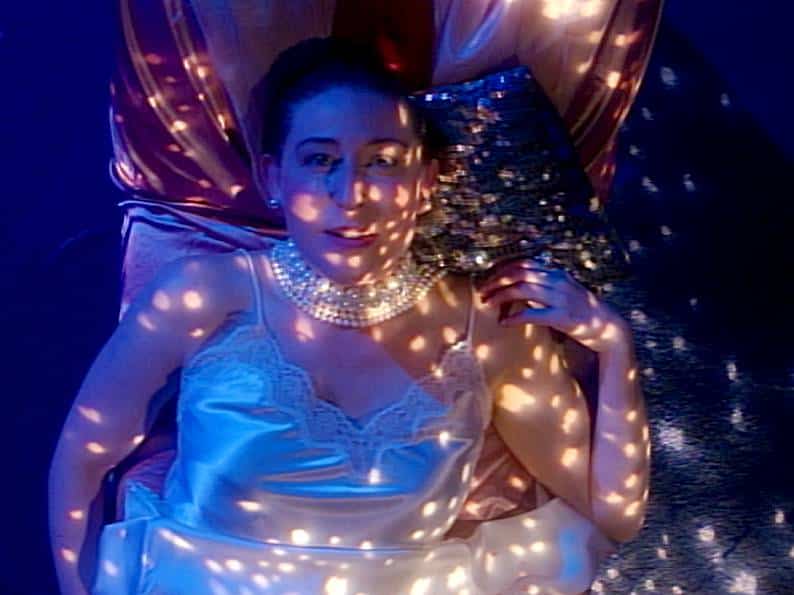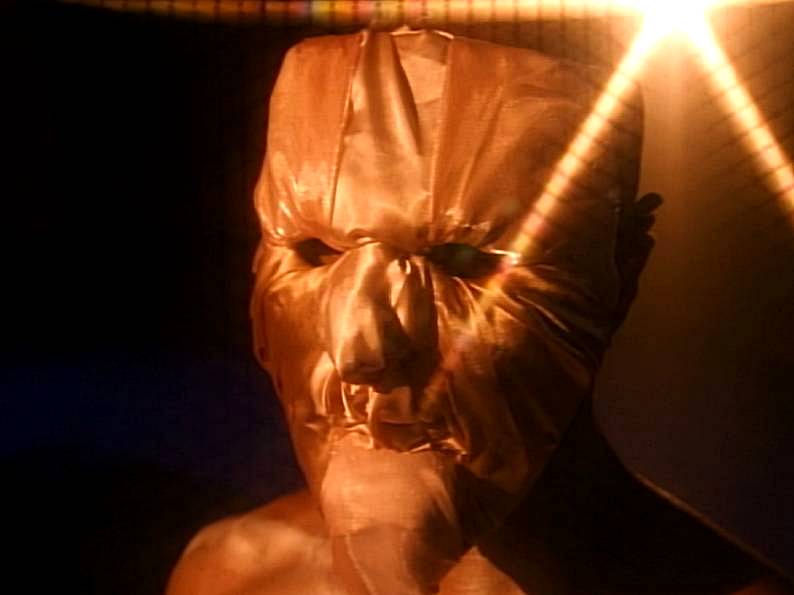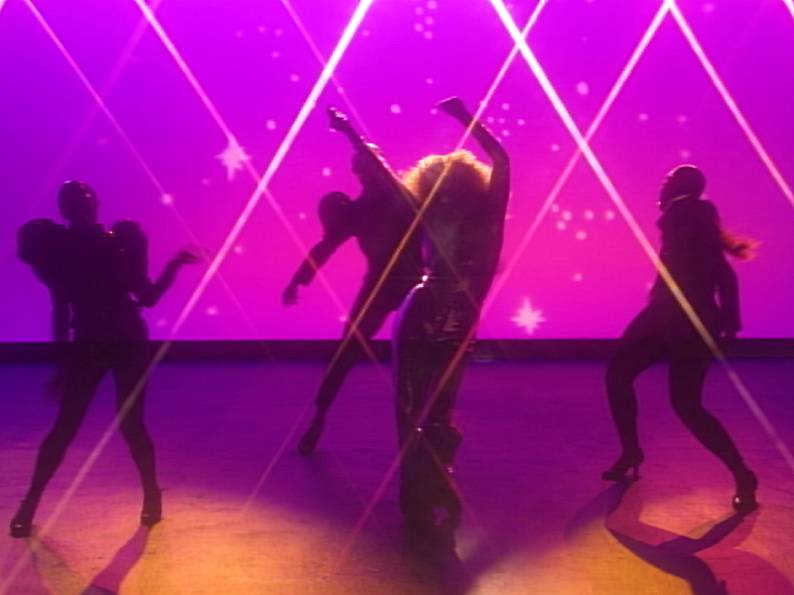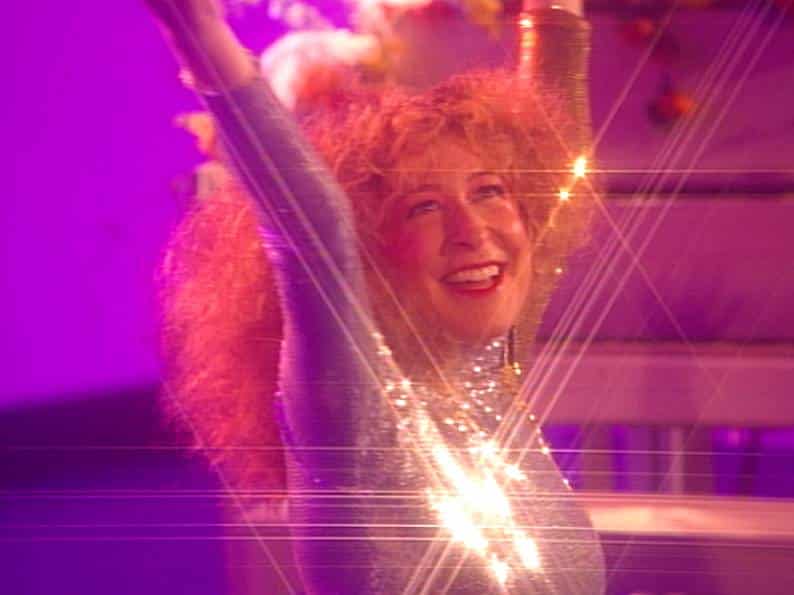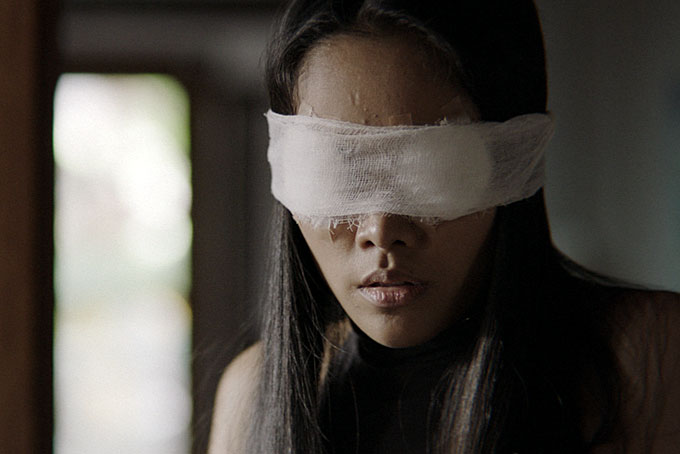words Christina Brennan
Give Me Pity! (2022) has more on its mind than horror movie jump-scares. Mockumentary horror – the sub-genre British audiences may associate with Ghostwatch (1992) and other BBC specials – meets satire in this snappy film from writer-director Amanda Kramer. Having premiered back in 2022 at the International Film Festival Rotterdam, Give Me Pity! benefits from Kramer’s knack for bringing new takes on familiar genre tropes by injecting anarchic horror into a live broadcast of a 1970s variety TV performance.
Variety shows are typically escapist television with star turns, disco routines and a range of glitter-adorned costumes. But you would be mistaken in assuming it was going to be an unwinding or relaxing experience watching Sissy St Claire (played with fantastic energy by Sophie von Haselberg) attempt to dazzle audiences with her first solo show. Kramer describes the US television special, A Special Olivia Newton-John, broadcast on ABC television in 1976, as a vivid influence on Give Me Pity!. Divided into eye-catching vignettes typical of the variety special format – featuring sketches, monologues and musical numbers – it’s easy to spot Kramer’s affection for the kitschy nature of late-night weekend television. Yet as you begin to absorb the rhythms of this part-parody and part-tribute to iconic television specials, you realise that that Give Me Pity! is a critique of the dark, self-destructive side of fame and the Faustian dangers involved in pursuing it.
Sissy St Claire’s opening monologue compares her image to Jesus (‘I’m very impressed by his dedication to making it. Jesus and I are both big entertainers’). She launches herself into successive ballads and dance numbers in a glitter-spangled dress (with tuneful lyrics, again, balling about ‘making it’ and ‘not faking it’). Yet, interspersed with these musical numbers are flashes of an ominous presence on the edge of the stage, a brooding masked man who interrupts her performance and sends her into a spiral of self-loathing. A fan mail segment – where a more mild-mannered version of Sissy St Claire reads letters from her audience – shows gushing fans become dismissive (‘You’d be so much prettier with your hair pushed back’) and then threatening (a letter covered in blood reads ‘Fat Cow. Moo. Moo. Moo’). All that glitters is not gold for Sissy St Claire. Misogyny, with a sinister, predatory edge, fuels attacks on her as she finds out, in real-time, that fame has a darker and dangerous side.
With escalating twists and turns, fame becomes an almost-occult force that ignites a bottomless thirst in those it captures, only to drown them in anger and rage. As a near-solo piece, it is up to Haselberg to convey this theme. From the opening shots, we know that Haselberg’s performance will make or break the film. She is a forceful screen presence that moves between absurdism and self-destruction. Give Me Pity! is a splendid amalgamation of head-spinning performances from its lead. We see Sissy St Claire belting out a diva-style ballad – singing about her knocking her audience dead and proving doubting agents and ex-boyfriends wrong with her success. Here, she is seemingly reclaiming any power she can, perhaps channelling genuine emotions and self-expression or showing a desperate desire to rebel against patriarchal expectations. She is a woman attempting to gain agency in any possible way – and the tragedy is she doesn’t quite manage it.
At a certain point, she is a heap on the stage floor, having been dragged through multiple extremes – adoration from her fans but ridicule and even violence that represents the punishing and destructive side of fame. Haselberg can maintain the glossy, superficial face of a performer whilst giving clear glimpses of the despair that erupts from beneath the surface.
By its end, the explicit horror element of Give Me Pity! almost feels redundant. It is not a scary film, in the typical sense, but more of a self-conscious satire with a deliberate nasty taste. Kramer can maintain a deft balance between thrills and pop-culture parody, all of which combine to create a psychedelic, surreal experience for the audience. Ultimately, Give Me Pity! is one for fans of experimental film and for lovers of absurdism. Kramer’s unconventional cinematography, which involves flashing colour and fast-moving editing, along with its focus on the interior life of Sissy St. Claire, places Give Me Pity! firmly as an example of modern feminist filmmaking.
Give Me Pity! is in select cinemas and on demand 10 November


